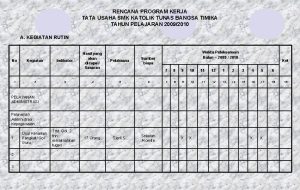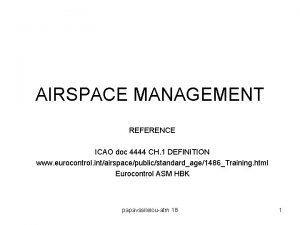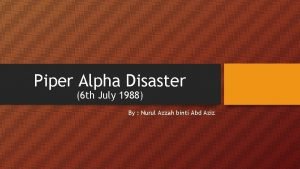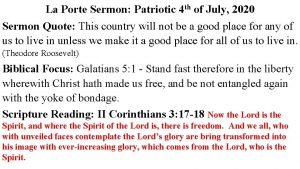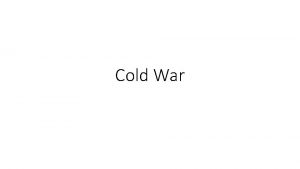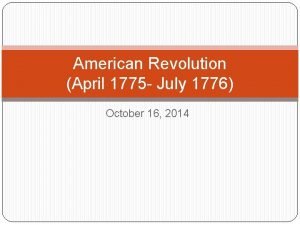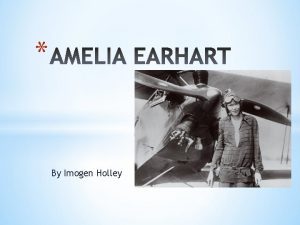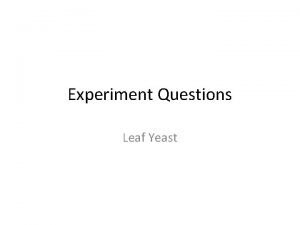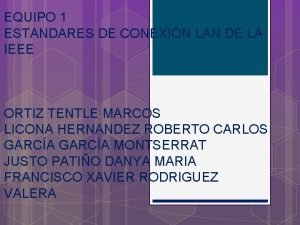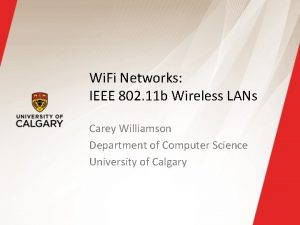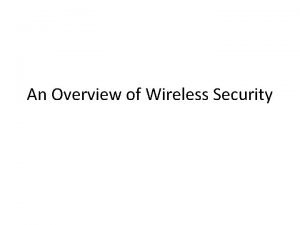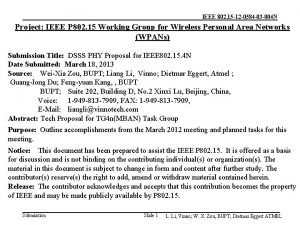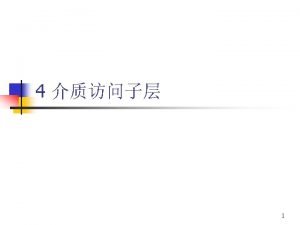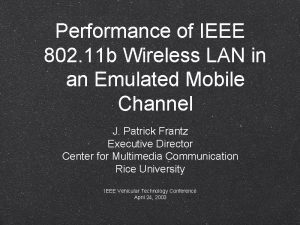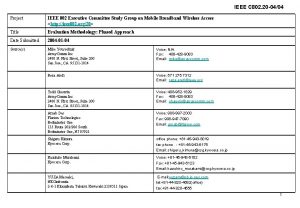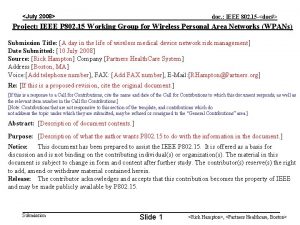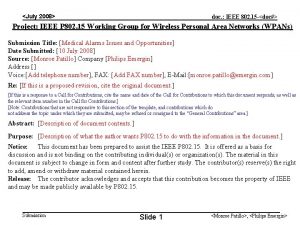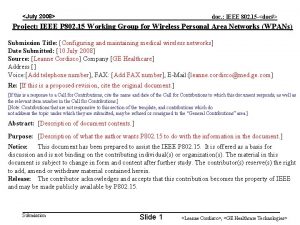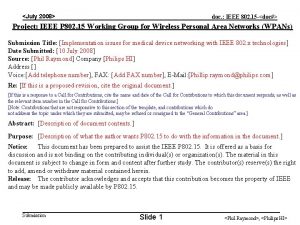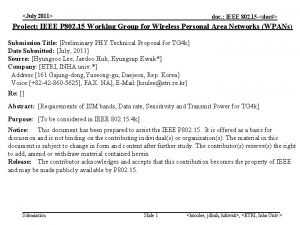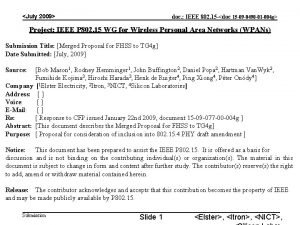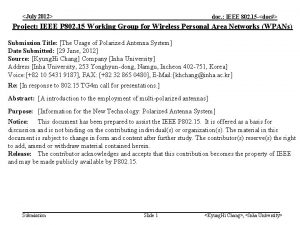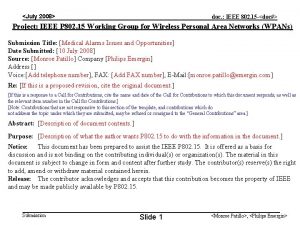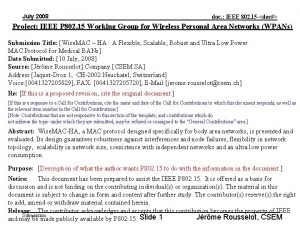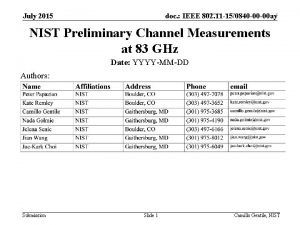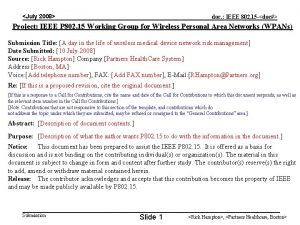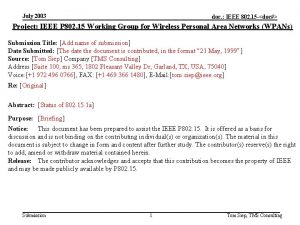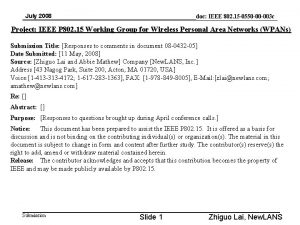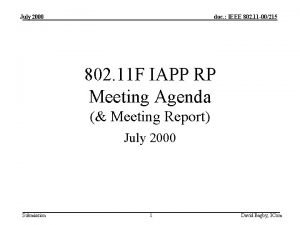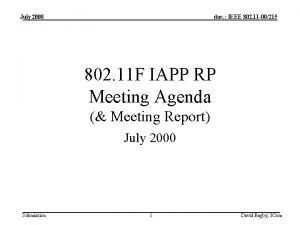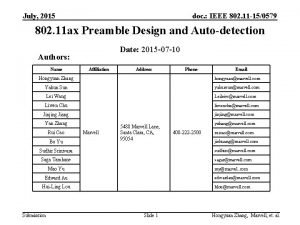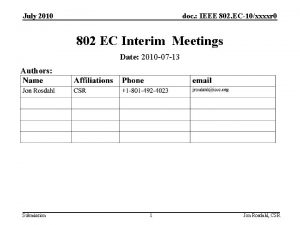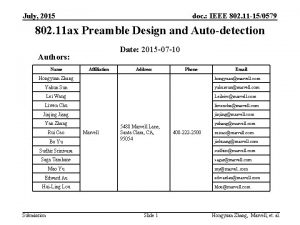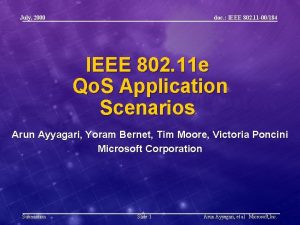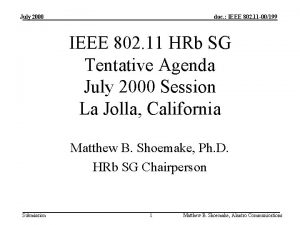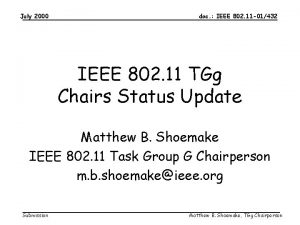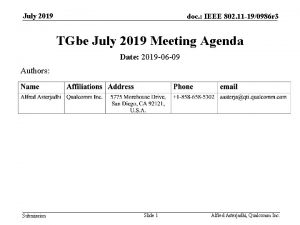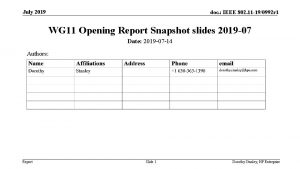July 2019 doc IEEE 802 11 191053 r


















































![July 2019 doc. : IEEE 802. 11 -19/1053 r 1 References [1] V. Jungnickel, July 2019 doc. : IEEE 802. 11 -19/1053 r 1 References [1] V. Jungnickel,](https://slidetodoc.com/presentation_image_h/1f26a475ee2ff2e28a9af927c3ee0ccf/image-51.jpg)
- Slides: 51

July 2019 doc. : IEEE 802. 11 -19/1053 r 1 LC-optimized PHY proposal for TGbb Authors: Submission Date: 2019 -07 -13 Slide 1 Volker Jungnickel – Fraunhofer HHI

July 2019 doc. : IEEE 802. 11 -19/1053 r 1 Abstract The submission presents the proposal for an LC-optimized PHY for TGbb based on G. 9991 PHY 1 [1]. Submission Slide 2 Volker Jungnickel – Fraunhofer HHI

July 2019 doc. : IEEE 802. 11 -19/1053 r 1 Philosophy of this proposal • We want to integrate Li. Fi into the 802. 11 ecosystem. This is key to the success as it allow seamless integration of Li. Fi into current networks. 1. This means that the interfaces towards upper layers (security, mobility, etc…) have to be fully 802. 11 compliant. • This compliancy is a must and independent on the choice of the PHY layer. 2. Efficient operation needs a PHY which is optimized for the medium. • Chose a highly performant PHY (bandwidth, spectral efficiency, complexity). • Once both is achieved, we will be able to integrate Li. Fi into any mobile chip. • Mobile chips include many physical layers today (LTE, Wi. Fi, Bluetooth, etc…). • Adding another PHY for Li. Fi is feasible and it only depends on economics. Submission Slide 3 Volker Jungnickel – Fraunhofer HHI

July 2019 doc. : IEEE 802. 11 -19/1053 r 1 Characteristics of LC PHYs LC requires a non-negative and real-valued baseband-signal. Bipolar signals can be turned non-negative by adding a DC-bias before transmission. TX DSP + Driver & LED optical channel Photodiode Highpass RX DSP DC It is removed by using a high-pass filter before reception. Submission Slide 4 Volker Jungnickel – Fraunhofer HHI

July 2019 doc. : IEEE 802. 11 -19/1053 r 1 Reuse OFDM PHYs for LC • Complex OFDM-baseband signals are real-valued after up-conversion to the carrier frequency fc. Data IFFT CP Up-conversion Re(. ) LED fc • For LC, one can change fc to a low carrier (“low IF”), yielding a real-valued baseband signal. Submission Slide 5 Volker Jungnickel – Fraunhofer HHI

July 2019 doc. : IEEE 802. 11 -19/1053 r 1 Use existing 802. 11 PHYs for LC • RF frontend up-converts baseband signals onto e. g. fc=2. 4 GHz. • LC frontend up-converts baseband onto low IF e. g. fc=BW/2 (+ Δ). – Δ 0 for analog upconversion – Δ=0 for oversampled digital upconversion • Efficient implementation needs changes from complex I/Q to digital up-conversion Submission Slide 6 Volker Jungnickel – Fraunhofer HHI

July 2019 doc. : IEEE 802. 11 -19/1053 r 1 Why a LC-optimized PHY is needed? • Bit-interleaved coded modulation (BICM) is the concept behind all existing 802. 11 PHYs. In RF NLOS channels, BICM works quite well. • BICM creates redundancy and permutes the coded bits randomly over all subcarriers. In a rare fading event, lost bits can be repaired by the FEC. • LC NLOS channels are 1 st order low-pass [1]. Same holds for the LED characteristics. In this case, the concept behind BICM may not work. Assuming 100 MHz bandwidth and 20 MHz cutoff, 80% of the bits will be lost. • Approach: Replace BICM by adaptive bitloading! Submission Slide 7 RF LC Volker Jungnickel – Fraunhofer HHI

July 2019 doc. : IEEE 802. 11 -19/1053 r 1 Use G. 9991 as LC-optimized PHY • LC-optimized PHY obviously needs adaptive bitloading – Robust operation in both, LOS and NLOS channel conditions • 802. 11 has discussed but never supported adaptive bitloading – Adaptive bitloading brings additional complexity and overhead • Ways to bring adaptive bitloading into 802. 11 a) Integrate G. 9991 as LC-optimized PHY under 802. 11 MAC o G. 9991 is already used in many LC demos and early products o Next-gen G. 9991 will have 1 GHz bandwidth (based on G. hn 2 coax) - use of lasers b) Integrate adaptive bitloading in next-gen 802. 11 RF PHY SG EHT o Next-gen RF PHY is limited to 320 MHz what is unlikely to be increased for LC Submission Slide 8 Volker Jungnickel – Fraunhofer HHI

July 2019 doc. : IEEE 802. 11 -19/1053 r 1 Use existing and LC-optimized PHY under 802. 11 MAC • 802. 11 MAC could integrate existing 802. 11 and LC-optimized PHY Submission Slide 9 Volker Jungnickel – Fraunhofer HHI

July 2019 doc. : IEEE 802. 11 -19/1053 r 1 Straw Poll from May 2019 meeting Are you interested in further presentations discussing the potential suitability of the G. 9991 PHY for 802. 11 bb? Y / N / A: Submission 6 / 0 / 5 Slide 10 Volker Jungnickel – Fraunhofer HHI

July 2019 doc. : IEEE 802. 11 -19/1053 r 1 Outline 1. LC-optimized waveform 1. 1. Main characteristics 1. 2. Forward Error Correction 1. 3. Adaptive Bitloading 1. 4. OFDM modulator SISO 2. PPDU format 2. 1. Synchronization header 2. 2. Physical layer header, HCS 2. 3. MIMO CE symbols 2. 4. PHY payload Submission Preamble CE symbols SHR Slide 11 PHY header optional MIMO HCS PHR MIMO CE symbols PSDU PHY payload Volker Jungnickel – Fraunhofer HHI

July 2019 doc. : IEEE 802. 11 -19/1053 r 1 1. LC-optimized waveform • Based on G. 9991 aka “G. vlc” • • ITU-T Recommendation (Q 18/15 “In-premises networking”) G. vlc project started in 2015, was approved on 01/04/2019 G. 9991 is largely based on G. 9960/61 (aka “G. hn”) Leverage the highly flexible OFDM engine provided by G. hn • Use of G. 9991 PHY 1 for light is approved by ITU-T and tested in devices • DCO-OFDM & frequency-upshift with fupshift=B/2, B is bandwidth defined by band plan • G. 9991 brings bitloading capability into LC-optimized waveform • Existing LC prototypes from several vendors prove functionality and high performance • Key is reuse of the existing waveform • Corresponding to PMA & PMD from G. 9991 • Reuse of G. 9991 implies no compromise for the performance Submission Slide 12 Volker Jungnickel – Fraunhofer HHI

July 2019 doc. : IEEE 802. 11 -19/1053 r 1 1. 1. Main characteristics of G. 9660 PHY • System architecture and PHY layer - Submission LDPC Forward Error Correction (FEC) Windowed OFDM (Orthogonal Frequency Division Multiplexing) QAM modulation up to 12 bit/s/Hz, selectable on each subcarrier Adaptive bitloading MIMO-capable Slide 13 Volker Jungnickel – Fraunhofer HHI

July 2019 doc. : IEEE 802. 11 -19/1053 r 1 Parameters Area Value Notes Modulation type DCO-OFDM Configurable OFDM parameters (cyclic prefix, per-subcarrier PSD, etc) Max modulation Up to 12 bits/subcarrier Each sub-carrier is modulated with a different number of bits, depending on SNR (Bitloading), Odd constellations are optional FEC LDPC FEC rates (1/2, 2/3, 5/6, 16/18, 20/21) and block sizes dynamically selected Spectrum 5 -200 MHz is used for LC Individual sub-carriers can be notched to coexist with other services Bandplans 50, 100, 200 MHz, … 256, 512 and 1024 subcarriers respectively, fully interoperable Subcarrier spacing 195 k. Hz (LC) Sub-carrier spacing optimized for the expected delay spread in LC medium Notches Yes Partial spectrum can be notched Min SNR for frame detection -3 d. B Bidirectional traffic Yes Submission Specific PHY frame for bidirectional traffic Slide 14 Volker Jungnickel – Fraunhofer HHI

© 3 / 2 / 0 2 1 M a r v e l l C o n July 2019 doc. : IEEE 802. 11 -19/1053 r 1 Functional model G. 9961 • Reuse the lower parts from G. 9991 PHY 1 G. 9960 • G. 9991 is a specific profile for LC based on G. 9960 • Reuse only PMA and PMD • Integrate lower PHY layer of G. 9991 into 802. 11 MAC • Proposed interface lies at the a-reference point Submission Slide 15 Volker Jungnickel – Fraunhofer HHI

July 2019 doc. : IEEE 802. 11 -19/1053 r 1 G. 9960 PHY description Submission Slide 16 Volker Jungnickel – Fraunhofer HHI

© 2 0 1 2 M a r v e l l C o n July 2019 doc. : IEEE 802. 11 -19/1053 r 1 Possible frame formats in G. 996 x vs. 802. 11 bb Application Entity Ethernet frame DLL layer APC sublayer LLC frame LLC sublayer LLC frame block LPDU MAC MPDU sublayer PHY layer Phy Frame Submission ADPU LFH Encrypted LLC frame has also CCMP header and MIC fields ADPU (data) or LCDU (LLC control) LLC frame f Segment h LPH LPDU h Preamble LLC frame f+1 Segment h+1 Segment h+2 CRC LPDU h+1 Header …. ACE symbols LLC frame g Segment h+3 Padding • Replaced by 802. 11 MAC Segment h+4 LPDU size = FEC block size (120 or 540 bytes) LPDU h+2 Payload Slide 17 LPDU h+3 LPDU h+4 Pad • From G. 9960 PHY Volker Jungnickel – Fraunhofer HHI

© 2 0 1 1 M a r v e l l C o n July 2019 doc. : IEEE 802. 11 -19/1053 r 1 1. 2. Forward error correction Scrambler • All data starting from the first bit of the PHY-frame header and ending by the last bit of the payload are scrambled using a pseudorandom sequence generated by the linear feedback shift register (LFSR) with the polynomial p(x) = x 23 + x 18 + 1. There are different ways to initialize the LFSR for header and payload data. Submission Slide 18 Volker Jungnickel – Fraunhofer HHI

© 2 0 1 1 M a r v e l l C o n July 2019 doc. : IEEE 802. 11 -19/1053 r 1 LDPC encoder • Why LDPC (Low-Density Parity Check) codes? • LDPC works better than other alternatives over a wide range of media (powerline, phoneline, coaxial and LC) and operation points (both low and high block error rates) • LDPC is the only code that works well at very high data rates (hundreds of Mbps) because it is easier to parallelize • LDPC is used by many other very high data rate standards: 10 GBase-T Ethernet (802. 3 an), Wi. MAX (802. 16 e), (802. 11 n, ac, ax) and 5 G NR Submission Slide 19 Volker Jungnickel – Fraunhofer HHI

© 3 / 2 / 0 2 1 0 1 2 1 M a r v e l l C o n July 2019 doc. : IEEE 802. 11 -19/1053 r 1 G. 9960 LDPC code (I) } 3 block sizes: 168, 960 and 4320 bits } 3 mother code rates: 1/2, 2/3 and 5/6 } Apart from the mother codes, 2 more rates are available by puncturing 5/6 rate (16/18 and 20/21) } Puncturing is used to generate higher rates by simply discarding some of the encoded bits. Puncturing is applied to both payload and parity bits. } Unpuncturing consists of inserting a zero-valued LLR in those codeword positions that were punctured at the encoder Submission Slide 20 Block length (bits) Codeword length (bits) Rate Expansion Factor 168 336 1/2 14 960 1920 1/2 80 960 1440 2/3 60 960 1152 5/6 48 960 1080 16/18 48 960 1008 20/21 48 4320 8640 1/2 360 4320 6480 2/3 270 4320 5184 5/6 216 4320 4860 16/18 216 4320 4536 20/21 216 Volker Jungnickel – Fraunhofer HHI

© 3 July 2019 doc. : IEEE 802. 11 -19/1053 r 1 / 2 G. 9960 LDPC code (II) / 0 } All the parity-check matrices in their compact form have 24 columns; depending on 2 1 the rate, they have 12 rows (1/2), 8 rows (2/3) and 4 rows (5/6) 0 1 2 } The parity-check matrices for the 1/2 and 2/3 rate are quite sparse. However, the ones for the 5/6 rate are pretty dense (see the examples below). 1 M a r v e l l N = 1920 ; R = 1/2 C o N = 5184 ; R = 5/6 n Volker Jungnickel – Fraunhofer HHI Submission Slide 21

July 2019 doc. : IEEE 802. 11 -19/1053 r 1 G. 9960 LDPC performance: pre-FEC BER vs. post-FEC BLER • code rate 1/2 allows robust transmission for small block size (header) • code rate 5/6 maximizes the throughput for large block size (payload) • further resilience is reached through fast repetition P. W. Berenguer et al. , "The benefit of frequency-selective rate adaptation for optical wireless communications, " 2016 10 th International Symposium on Communication Systems, Networks and Digital Signal Processing (CSNDSP), Prague, 2016. Submission Slide 22 Volker Jungnickel – Fraunhofer HHI

July 2019 doc. : IEEE 802. 11 -19/1053 r 1 G. 9960 LDPC and Shannon bound minimal SNR for BLER 1 e-3 FEC RATE BPC 1/2 2/3 5/6 16/18 20/21 12 24 28. 6 33. 6 35. 6 38. 2 10 19. 9 24. 1 28. 3 30. 1 32. 5 8 15. 6 19. 3 22. 9 24. 6 26. 7 6 11. 3 14. 5 17. 6 19 21 4 6. 75 9. 4 12 13. 2 15 3 4. 1 6. 5 8. 9 10 11. 7 2 1. 44 3. 5 5. 7 6. 7 8. 4 1 -1. 5 6 2. 7 3. 7 5. 4 Points marked with “o” in the curve of each code rate represent 4 QAM, 16 QAM, 64 QAM, 256 QAM and 1024 QAM constellations respectively Submission Slide 23 Volker Jungnickel – Fraunhofer HHI

July 2019 doc. : IEEE 802. 11 -19/1053 r 1 Repetition encoding Submission Slide 24 Volker Jungnickel – Fraunhofer HHI

July 2019 doc. : IEEE 802. 11 -19/1053 r 1 1. 3. Adaptive Bitloading Adaptive bitloading algorithm data (from FEC) PSD (d. Bm/Hz) Tone mapping Constellation encoding Frequency-domain transmit power shaping Signal Received by STA #1 SNR at STA #1 Bitloading for STA #1 Noise spectrum Different STAs are using different modulations!! TX spectrum f(MHz) Constellation scrambling Signal Received symbols/subcarrier by STA #2 (to OFDM modulator) Submission RX spectrum in STA #1 RX spectrum in STA #2 SNR at STA #2 Bitloading for STA #2 Noise spectrum Slide 25 Volker Jungnickel – Fraunhofer HHI

July 2019 doc. : IEEE 802. 11 -19/1053 r 1 Benefits of G. 9960 bitloading mechanism • System is constantly measuring SNR between all nodes (in both directions) and adapting the bit-loading in real-time. • In this way, the system becomes resilient against any problems in the medium. • Works well despite severe frontend impairments (high-pass and low-pass, nonlinear LED and driver characteristics). • Works well despite severe multipath propagation in some LC channels (LOS+NLOS). • STAs can use their best possible modulation allowed by own SNR. • No need to add SNR margin to ensure far-away STAs get zero packet-loss. Submission Slide 26 Volker Jungnickel – Fraunhofer HHI

July 2019 doc. : IEEE 802. 11 -19/1053 r 1 Tone mapping • Tone mapping is based on bit allocation tables (BATs) • Transmitter-defined BATs are typically pre-defined (same modulation on all subcarriers). • Runtime BATs can be defined by the transmitter or receiver (variable modulation on each subcarrier) where number of bits depends on signal-to-noise ratio (SNR) on each subcarrier. BAT_ID 0 1 2 to 7 8 to 31 Type predefined runtime Content uniform 1 -bit loading on all subcarriers uniform 2 -bit loading on all subcarriers, reserved see below • Unloaded subcarriers are loaded with a pseudorandom binary sequence using linear feedback shift register (LFSR) with the polynomial p(x) = x 23 + x 18 + 1. Submission Slide 27 Volker Jungnickel – Fraunhofer HHI

July 2019 doc. : IEEE 802. 11 -19/1053 r 1 Constellation encoding b=1 b=2 b=3 b=4 (first quadrant) • Square constellations for even number of bits (b=2, 4, 6, 8, 10, 12) • mandatory at Tx and Rx • Cross-shaped constellations for odd number of bits (B= 1, 3, 5, 7, 9, 11) • mandatory at Tx, optional at Rx Submission Slide 28 Volker Jungnickel – Fraunhofer HHI

July 2019 doc. : IEEE 802. 11 -19/1053 r 1 Frequency-domain transmit spectrum shaping • Achieved by a scaling factor tss defined on each subcarrier. • Set by the transmitter between 0 and -30 d. B in steps of -0. 5 d. B. • Allows vendors to statically pre-distort the transmitted signal and adapt it to non-ideal driver + LED characteristic • Allows dynamic fine tuning of BER per subcarrier via adaptive power loading Submission Slide 29 Volker Jungnickel – Fraunhofer HHI

July 2019 doc. : IEEE 802. 11 -19/1053 r 1 Constellation scrambling • Constellation scrambling is useful to randomize interference from other APs/STAs. • The phase of constellation points is shifted according to the PRBS generated by a LFSR by using the polynomial g(x) = x 13 + x 12 + x 11 + x 8 + 1. • The LFSR is advanced by two bits for supported and masked subcarriers. The two LSBs of the LFSR are taken to determine the phase shift of the constellation scrambler. LFSR output s 2 0 0 1 1 Submission Slide 30 s 1 0 1 Phase shift (rad) 0 π/2 π 3 π/2 Volker Jungnickel – Fraunhofer HHI

July 2019 doc. : IEEE 802. 11 -19/1053 r 1 Bitloading example • TGbb channel model for industrial wireless • Channel frequency responses seen by the different receiver photodiodes D 1 -D 8 • Channel frequency response for receiver at D 2 PSD (d. Bm/Hz) • Shows strong fade at around 65 MHz Fewer bits are loaded around this frequency • Frequency-selective transmit power shaping makes BER on all subcarriers equal, i. e. FEC faces AWGN-like error statistics despite multipath fading in the channel P. W. Berenguer et al. , "The benefit of frequency-selective rate adaptation for optical wireless communications, " 2016 10 th International Symposium on Communication Systems, Networks and Digital Signal Processing (CSNDSP), Prague, 2016. Submission Slide 31 Volker Jungnickel – Fraunhofer HHI

July 2019 doc. : IEEE 802. 11 -19/1053 r 1 1. 4. OFDM modulator • Start is complex OFDM waveform with IFFT and CP • Windowing avoids EMI over phone and power line, not used for coax and LC • Frequency upshift to realize real-valued passband signal • DC-offset realizes non-negative waveform for POF, LC Submission Slide 32 Volker Jungnickel – Fraunhofer HHI

July 2019 doc. : IEEE 802. 11 -19/1053 r 1 Numerology for LC-optimized PHY Waveform DC biased OFDM Subcarrier Spacing FSC 195. 3125 KHz OFDM Symbol Duration 5120 ns Cyclic Prefix length for header (payload) 1. 280 (k*160) ns, k=1… 8 Number of bits/subcarrier 1, 2, 3, 4, 5, 6, 7, 8, 9, 10, 11, 12 FEC, Information Block Size LDPC, 21, 120 or 540 bytes Code Rates 1/2, 2/3, 5/6, 16/18, 20/21 Bandplan / MHz Clock cycle / ns Frequency up-shift FUS / MHz N (Nsupported) / clock cycles 50 20 25 100 10 200 5 Submission Gross data rate / Mbit/s Min. Max. 256 (245) 23 530 50 512 (501) 47 1084 100 1024 (1013) 96 2192 Slide 33 Volker Jungnickel – Fraunhofer HHI

July 2019 doc. : IEEE 802. 11 -19/1053 r 1 IDFT Submission Slide 34 Volker Jungnickel – Fraunhofer HHI

July 2019 doc. : IEEE 802. 11 -19/1053 r 1 Cyclic prefix • The CP provides a guard interval between adjacent OFDM symbols to protect against intersymbol interference (ISI). • The CP is implemented by prepending the last NCP samples of the IDFT output to its output N samples. The first sample is the IDFT output sample N-NCP. The last sample of the CP is the IDFT output sample N-1. The next sample is the IDFT output sample 0. • Total OFDM symbol duration is NW = N + NCP samples. The value of NCP varies during a frame. • In the header and first two symbols after the header, NCP=NGI-HD=N/4. All the rest of the payload has the same value NCP=NGI. Submission Slide 35 Volker Jungnickel – Fraunhofer HHI

July 2019 doc. : IEEE 802. 11 -19/1053 r 1 Frequency upshift Submission Slide 36 Volker Jungnickel – Fraunhofer HHI

July 2019 doc. : IEEE 802. 11 -19/1053 r 1 2. PPDU structure SISO Preamble CE symbols SHR Submission PHY header optional MIMO HCS MIMO CE symbols PSDU PHY payload PHR Slide 37 • • SISO = single-input single-output MIMO = multiple-input multiple-output SHR = Synchronization header CE = Channel estimation PHR = Physical layer header HCS = Header check sequence PSDU = PLCP Service Data Unit PLCP = Physical layer convergence protocol Volker Jungnickel – Fraunhofer HHI

July 2019 doc. : IEEE 802. 11 -19/1053 r 1 2. 1. Synchronization header (SHR) Synch preamble CE symbols N 1 = 10 N 2 = 4 N 3 = 2. 5 b = 0 for coax, LC Preamble time domain generation Submission Slide 38 Volker Jungnickel – Fraunhofer HHI

July 2019 doc. : IEEE 802. 11 -19/1053 r 1 Synch preamble • The synch preamble consists of two sections. • First section comprises 10 repetitions of an OFDM symbol S employing subcarrier spacing 4 × FSC, where FSC denotes the subcarrier spacing. • The second section comprises 4 repetitions of the inverted symbol -S. • The synch preamble uses the subcarriers with indices 4, 8, 12, 16, …, N-4. • At first, bit sequence of all ones is mapped using the 1 -bit constellation. • Next, the LFSR generator of the constellation scrambler is initialized as 16 E 616=1011011100110. The LFSR is advanced by two bits per subcarrier. • The output of the mapper is rotated using the two LSBs of the LFSR. • The resulting constellation sequence is finally fed into the OFDM modulator. Submission Slide 39 Volker Jungnickel – Fraunhofer HHI

July 2019 doc. : IEEE 802. 11 -19/1053 r 1 CE symbols • The CE sequence is used for header detection. • It comprises 2. 5 repetitions of an OFDM symbol S employing subcarrier spacing 1 × FSC, where FSC denotes the subcarrier spacing. • The number of repetitions is a non-integer number to indicate that two OFDM symbols are used so that the CP is the same as in the PHY header, i. e. NCP=NGI-HD=N/4. • In the channel estimation preamble, all subcarriers are used. • A bit sequence of all ones is mapped using the 1 -bit constellation. • Next, the LFSR generator of the constellation scrambler is initialized as 110516= 100000101. The LFSR is advanced by two bits for all subcarriers. • The output of the mapper is rotated using the two LSBs of the LFSR. • The resulting constellation sequence is finally fed into the OFDM modulator. Submission Slide 40 Volker Jungnickel – Fraunhofer HHI

July 2019 doc. : IEEE 802. 11 -19/1053 r 1 2. 2. PHY header Frame type Domain identifier Source node Destination node Duration Header Extended segmentation header indication Indication Multicast indication Frame-specific fields Header check sequence Core header: Common to all PHY frames (both G. hn/vlc and 802. 11) Frame-type specific header: Specific for each frame type FT field contains extension pointer to further frame types. Can be defined by 802. 11 Submission Slide 41 Volker Jungnickel – Fraunhofer HHI

July 2019 doc. : IEEE 802. 11 -19/1053 r 1 Header check sum (HCS) • The HCS uses CRC-16. • It starts with LSB of first field and ends with the MSB of last field of PHY frame header. • The HCS is computed using the following generator polynomial: G(x) = x 16 + x 12 + x 5 + 1 • The value of the HCS shall be the remainder after the contents (treated as a polynomial where the first input bit is associated with the highest degree, XPHYH– 17, where PHYH is the header length in bits, and the last input bit is associated with X 0) of the calculation field is multiplied by x 16 and then divided by G(x). • The HCS field is transmitted starting with the coefficient of highest order term. • The HCS bits shall be processed in the transmitted order. • The registers shall be initialized to all ones. Submission Slide 42 Volker Jungnickel – Fraunhofer HHI

July 2019 doc. : IEEE 802. 11 -19/1053 r 1 Header encoding • The size of the FEC code word is 168 bit and coding rate is ½. • The header repetition encoder (HRE) works as follows • The FEC codeword is first copied M times, where M = ceiling (k. H/NFEC), k. H is the number of bits to be loaded on to the OFDM symbol carrying the header (i. e. 336). • The first encoded header block is formed by concatenation of M copies of the header FEC encoder output. The bits (bi) within each codeword are cyclically shifted by 2 bits as follows • • 1 st copy is {b 0, b 1, …, b. NFEC– 2, b. NFEC– 1}. 2 nd copy is {b 2, b 3, …, b. NFEC – 1, b 0, b 1}. 3 rd copy is {b 4, b 5, …, b. NFEC– 1, b 0, b 1, b 2, b 3}. Mth copy, where M > 3, is {b(2×M– 2), b(2×M– 1), …, b. NFEC– 1, b 0, b 1, …, b(2×M– 4), b(2×M– 3)}. • There is a similar rule if there is a second encoded header block, see G. 9660. Submission Slide 43 Volker Jungnickel – Fraunhofer HHI

July 2019 doc. : IEEE 802. 11 -19/1053 r 1 Header segmentation • The encoded header block is segmented into symbol frames. • Header symbol frames are passed to the adaptive bitloading using a fixed constellation of 2 bits per subcarrier. • The encoded header block is segmented into D = 1, 2 OFDM symbol frames. • First k. H bits of the first encoded header block is mapped into the first symbol frame, so that b 0 is transmitted first. • If D = 2, the first k. H bits of the second encoded header block is mapped into the second symbol frame, so that b. NFEC/2 is transmitted first. • The rest of the bits of the first and the second encoded header blocks are discarded. Submission Slide 44 Volker Jungnickel – Fraunhofer HHI

July 2019 doc. : IEEE 802. 11 -19/1053 r 1 2. 3. MIMO CE symbols • LC can have many TRXs in one room that may be considered as remote optical front ends controlled by the same AP. The number of LEDs can be in the order of 100 and more. The 802. 11 way of defining MIMO CE symbols would require 100 s of MIMO reference symbols which is not adequate. • We can pack MIMO reference symbols denser in the frequency domain. • Relation between channel in frequency and time domain is a set of equations. • Not all subcarriers must contain pilots to identify the channel for one LED. • There can be no more taps in the channel than samples in the guard interval. • Every N/NCP=5120 ns/ (k*160) ns = 32/kth subcarrier actually needs a pilot. Submission Slide 45 Volker Jungnickel – Fraunhofer HHI

July 2019 doc. : IEEE 802. 11 -19/1053 r 1 Orthogonal combs with frequency reuse • Use a comb of equally-spaced subcarriers. A cyclic shift in the frequency domain identifies the LED. One comb is reserved for noise estimation. • The channel is interpolated between non-zero subcarriers. • Classical frequency reuse schemes can be applied for pilot assignments to LEDs. Submission Slide 46 Volker Jungnickel – Fraunhofer HHI

July 2019 doc. : IEEE 802. 11 -19/1053 r 1 Formal definition of MIMO CE symbols • Construction of MIMO RS starts from the LFSR also used in the SHR. • RS for the first LED use the subcarriers with indices Δ, 2Δ, 3Δ, 4Δ, …, N-Δ, where Δ is the comb spacing. The value of Δ is defined by higher layers taking the Δ≤N/NCP into account. • A bit sequence of all ones is mapped onto used subcarriers using the 1 -bit constellation. • The LFSR generator of the constellation scrambler is initialized as 16 E 616=1011011100110. • The LFSR is advanced by two bits per subcarrier. The output of the mapper is rotated using the two LSBs of the LFSR. • The resulting constellation sequence is finally fed into the OFDM modulator. • For CS≥ 1, a cyclic shift of the comb is performed so that subcarriers with indices CS, Δ+CS, 2Δ+CS, 3Δ+CS, 4Δ+CS, …, N-Δ+CS are used. • By using a single RS, up to CSmax ≤Δ-1 streams or transmitters can be identified. Submission Slide 47 Volker Jungnickel – Fraunhofer HHI

July 2019 doc. : IEEE 802. 11 -19/1053 r 1 MIMO CE for more than Δ-1 LEDs • The MAC layer will add more RSs for more transmitters as indicated by NRS. In this way, up to NRS*(Δ-1) streams can be identified. • Decompose the identifier of the ith transmitter as i=a*(Δ-1)+b where b<Δ-1 • The comb shift is then CS=b. The corresponding RS is now multiplied with the entries in the ath row of the Mx. M Hadamard matrix HK where M=2 K. HK is obtained iteratively by incrementing k from k=1…K as Submission Slide 48 Volker Jungnickel – Fraunhofer HHI

July 2019 doc. : IEEE 802. 11 -19/1053 r 1 2. 4. PHY payload Block length (bits) Codeword length (bits) Rate Expansio n Factor 168 336 1/2 14 960 1920 1/2 80 960 1440 2/3 60 960 1152 5/6 48 960 1080 16/18 48 960 1008 20/21 48 4320 8640 1/2 360 4320 6480 2/3 270 4320 5184 5/6 216 4320 4860 16/18 216 4320 4536 20/21 216 • The PHY payload is divided into sequential blocks of information bits, K bits per block each encoded by the FEC. The table shows valid values of K, block size NFEC, and code rate R. • In normal mode (REP = 001 in PHY header), codewords are passed directly to the output. • In robust mode, each FEC codeword is repeated REP times and concatenated at the output. • For more details on the sophisticated repetition scheme, see G. 9660. Submission Slide 49 Volker Jungnickel – Fraunhofer HHI

July 2019 doc. : IEEE 802. 11 -19/1053 r 1 Summary • It is proposed in TGbb to integrate lower parts (PMA and PMD) from ITU-T Rec. G. 9991 as LC-optimized PHY under 802. 11 MAC. • This PHY is also used by G. vlc and in IEEE P 802. 15. 13 which use different MAC protocols. All these standards address different market segments. • Using same PHY allows coexistence and interoperability between devices. • A detailed functional description was presented, mostly based on G. 9991 and G. 9660 recommendations of ITU-T. • This slide set is followed by simulation results detailed in doc. 11 -19/1054. • High performance is proven by numerous demos, prototypes and products from several vendors, see e. g. doc. 11 -19/1208. Submission Slide 50 Volker Jungnickel – Fraunhofer HHI
![July 2019 doc IEEE 802 11 191053 r 1 References 1 V Jungnickel July 2019 doc. : IEEE 802. 11 -19/1053 r 1 References [1] V. Jungnickel,](https://slidetodoc.com/presentation_image_h/1f26a475ee2ff2e28a9af927c3ee0ccf/image-51.jpg)
July 2019 doc. : IEEE 802. 11 -19/1053 r 1 References [1] V. Jungnickel, V. Pohl, S. Nonnig and C. von Helmolt, "A physical model of the wireless infrared communication channel, " in IEEE JSAC, vol. 20, no. 3, pp. 631 -640, April 2002. [2] V. Jungnickel, K. L. Bober, A. Paraskevopoulos, N. Serafimovski, H. Haas, “Proposed way forward on PHY in TGbb”, doc. 11 -19/0388 r 0. [3] K. L. Bober, M. Emmelmann, V. Jungnickel, A. Corici, D. Xiong; “LCoptimized PHY for TGbb”, doc. 11 -19/0865 r 1. [4] ITU-T G. 9991 - https: //www. itu. int/rec/T-REC-G. 9991 -201903 -P [5] ITU-T G. 9660 - https: //www. itu. int/rec/T-REC-G. 9960 [6] P. Wilke Berenguer et. al. : The benefit of frequency-selective rate adaptation for optical wireless communications, IEEE CSBDSP 2016. [7] https: //www. photonics 21. org/ppp-projects/workgroup-4/Eliot. php Submission Slide 51 Volker Jungnickel – Fraunhofer HHI
 Bridges from 802.x to 802.y
Bridges from 802.x to 802.y Bridges from 802.x to 802.y
Bridges from 802.x to 802.y Bluetooth ieee 802
Bluetooth ieee 802 802 ieee
802 ieee Ieee 802
Ieee 802 Ieee 802 family
Ieee 802 family Ieee 802 3 compliance
Ieee 802 3 compliance Ieee 802
Ieee 802 Arquitetura ieee 802
Arquitetura ieee 802 Modelo ieee 802
Modelo ieee 802 Ieee 802 standard
Ieee 802 standard Program kerja tata usaha smk
Program kerja tata usaha smk Doc 8071
Doc 8071 6th july 1988
6th july 1988 July 4 sermon
July 4 sermon What is the significance of july 4 1776 brainpop
What is the significance of july 4 1776 brainpop July 1-4 1863
July 1-4 1863 July 26 1953
July 26 1953 July 12 1776
July 12 1776 Under the rug chris van allsburg
Under the rug chris van allsburg Gdje se rodio nikola tesla
Gdje se rodio nikola tesla 2003 july 17
2003 july 17 July 14 1789
July 14 1789 June too soon july stand by
June too soon july stand by Poppies in july aoifes notes
Poppies in july aoifes notes Gcc july 2020
Gcc july 2020 July 16 1776
July 16 1776 Sensory language definition
Sensory language definition Monday 13th july
Monday 13th july Ctdssmap payment schedule july 2021
Ctdssmap payment schedule july 2021 July 30 2009 nasa
July 30 2009 nasa Malaga in july
Malaga in july July 2 1937 amelia earhart
July 2 1937 amelia earhart Miss cuba receives an invitation
Miss cuba receives an invitation Antwrp
Antwrp Super saturday tribal bingo july 4
Super saturday tribal bingo july 4 On july 18 2001 a train carrying hazardous chemicals
On july 18 2001 a train carrying hazardous chemicals July 1969
July 1969 Sources nso frenchhowell neill mit technology...
Sources nso frenchhowell neill mit technology... Growth of leaf yeast experiment
Growth of leaf yeast experiment Another place another time harris burdick
Another place another time harris burdick June 22 to july 22
June 22 to july 22 Imagery in poppies in july
Imagery in poppies in july 2001 july 15
2001 july 15 June july august
June july august Estandares 802
Estandares 802 802 11 b
802 11 b 802-11-wireless-security
802-11-wireless-security 802 15
802 15 802 3
802 3 802 11 b
802 11 b 802 20
802 20











